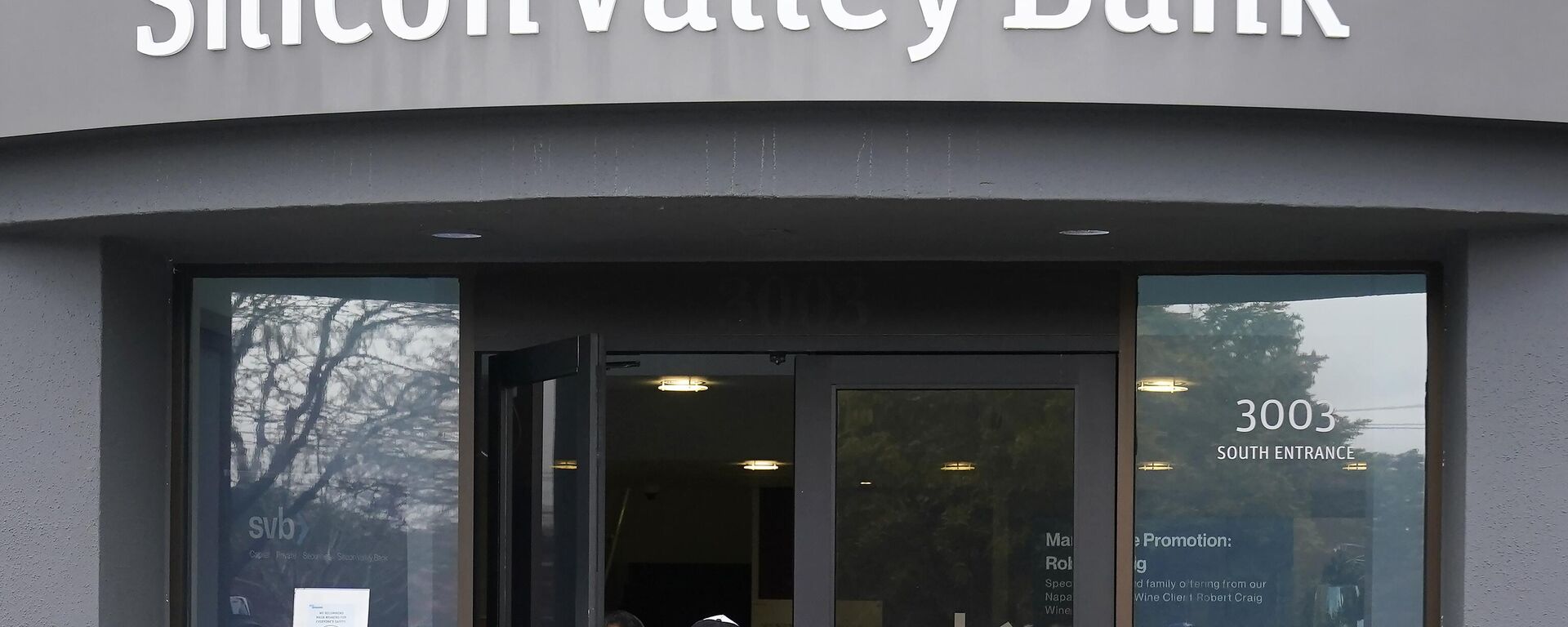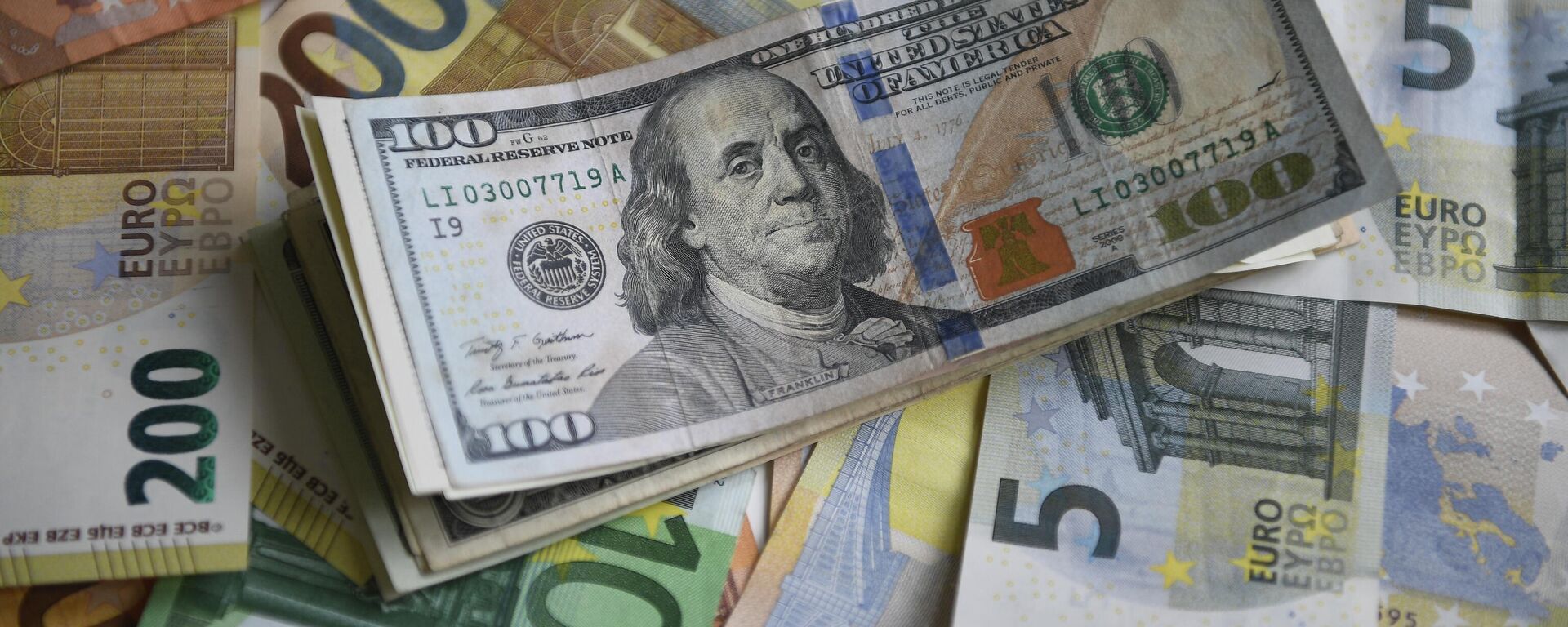https://sputnikglobe.com/20230318/at-least-186-us-banks-at-potential-risk-of-a-run-similar-to-svb-economists-warn--1108531654.html
At Least 186 US Banks At 'Potential Risk of a Run' Similar to SVB, Economists Warn
At Least 186 US Banks At 'Potential Risk of a Run' Similar to SVB, Economists Warn
Sputnik International
At least 186 US banks at 'potential risk of a run' similar to SVB, a study carried out by economists has warned.
2023-03-18T11:18+0000
2023-03-18T11:18+0000
2023-03-18T12:12+0000
economy
us
silicon valley bank collapse
silicon valley bank
inflation
us federal reserve bank
interest rate
run on banks
https://cdn1.img.sputnikglobe.com/img/07e7/03/12/1108531287_0:161:3071:1888_1920x0_80_0_0_6243a3198f62597441baa34842fbfaa4.jpg
At least 186 US banks are potentially facing the same risks as the recently-collapsed Silicon Valley Bank, a study by a group of economists has warned.All of these moneylenders are challenged by similar issues, the researchers stated, citing calculations indicating recent declines in bank asset values. The team, including the University of Southern California's Erica Xuewei Jiang, Gregor Matvos from Northwestern University's Kellogg School of Management, Tomasz Piskorski of Columbia University's Columbia Business School, Finance, and Stanford University's Amit Seru, warned of increased vulnerability of the US banking system to "uninsured depositor runs" like that which led SVB to fail.On March 10, the Federal Deposit Insurance Corporation (FDIC) announced that it was taking over SVB after it became the second-largest lender to collapse in US history, and the largest since the 2008 financial crisis.In a frenzy run on SVB, concerned customers withdrew their uninsured deposits after the moneylender’s assets were diminished amid the US Federal Reserve’s relentless interest rate hike campaign.The economists analyzed US banks' "asset exposure" as the country's central banking system continued to raise interest rates to determine possible implications for financial stability.Bank asset books, market value losses, and funding percentages were assessed during the research. The team explained that US Treasury notes and mortgage loans were the kind of assets that were susceptible to decreases in value when new bonds offer higher rates. As funding derived from uninsured depositors - those with accounts holding over $250,000 - was studied by the economists, they zeroed in on what they claimed was a potential problem. The team computed a similar sum of factors that led to SVB's decline potentially impacting all US banks. It was then determined that insufficient assets available for all depositors could result in almost 190 banks facing potential risk of impairment to insured depositors if half of the uninsured depositors rushed to swiftly withdraw funds from any of the American banks in question.Furthermore, potentially $300 billion in insured deposits might face losses. The next step for such banks would be intervention from the Federal Deposit Insurance Corporation."Our calculations suggest these banks are certainly at a potential risk of a run, absent other government intervention or recapitalization," the research concluded.
https://sputnikglobe.com/20230315/taxpayers-bailing-out-venture-capitalists-after-silicon-valley-bank-collapse-1108417164.html
https://sputnikglobe.com/20230316/is-my-money-100-safe-in-the-bank-no-but-here-are-some-tips-to-reduce-risks-1108475956.html
Sputnik International
feedback@sputniknews.com
+74956456601
MIA „Rossiya Segodnya“
2023
News
en_EN
Sputnik International
feedback@sputniknews.com
+74956456601
MIA „Rossiya Segodnya“
Sputnik International
feedback@sputniknews.com
+74956456601
MIA „Rossiya Segodnya“
186 us banks, at potential risk of a run', similar to svb collapse, silicon valley bank collapse, uninsured deposits, insured deposits, bank's asset books, market value losses, funding percentages assessed, banks at a potential risk of a run, absent government intervention, recapitalization
186 us banks, at potential risk of a run', similar to svb collapse, silicon valley bank collapse, uninsured deposits, insured deposits, bank's asset books, market value losses, funding percentages assessed, banks at a potential risk of a run, absent government intervention, recapitalization
At Least 186 US Banks At 'Potential Risk of a Run' Similar to SVB, Economists Warn
11:18 GMT 18.03.2023 (Updated: 12:12 GMT 18.03.2023) After the US’ Silicon Valley Bank (SVB) collapsed at breakneck speed, followed by the banks Signature and Silvergate, along with the Credit Suisse crisis, the US Federal Reserve's policy of rampant interest rate hikes was blamed for pushing moneylenders into insolvency.
At least 186 US banks are potentially facing the same risks as the
recently-collapsed Silicon Valley Bank, a study by a group of economists has warned.
All of these moneylenders are challenged by similar issues, the researchers stated, citing calculations indicating recent declines in bank asset values. The team, including the University of Southern California's Erica Xuewei Jiang, Gregor Matvos from Northwestern University's Kellogg School of Management, Tomasz Piskorski of Columbia University's Columbia Business School, Finance, and Stanford University's Amit Seru,
warned of increased vulnerability of the US banking system to "
uninsured depositor runs" like that which led SVB to fail.
On March 10, the Federal Deposit Insurance Corporation (FDIC) announced that it was taking over SVB after
it became the second-largest lender to collapse in US history, and the largest since the 2008 financial crisis.
In a frenzy run on SVB, concerned customers withdrew their uninsured deposits after the moneylender’s assets were diminished amid the
US Federal Reserve’s relentless interest rate hike campaign.
The economists analyzed US banks' "asset exposure" as the country's central banking system continued to raise interest rates to determine possible implications for financial stability.
Bank asset books, market value losses, and funding percentages were assessed during the research. The team explained that US Treasury notes and mortgage loans were the kind of assets that were susceptible to decreases in value when new bonds offer higher rates. As funding derived from uninsured depositors - those with accounts holding over $250,000 - was studied by the economists, they zeroed in on what they claimed was a potential problem.
The team computed a similar sum of factors that led to SVB's decline potentially impacting all US banks. It was then determined that insufficient assets available for all depositors could result in almost 190 banks facing potential risk of impairment to insured depositors if half of the uninsured depositors rushed to swiftly withdraw funds from any of the American banks in question.
Furthermore, potentially $300 billion in insured deposits might face losses. The next step for such banks would be intervention from the Federal Deposit Insurance Corporation.
"10 percent of the banks have larger unrecognized losses than those at SVB. Nor was SVB the worst capitalized bank, with 10 percent of banks having lower capitalization than SVB. On the other hand, SVB had a disproportional share of uninsured funding: only 1 percent of banks had higher uninsured leverage. Combined, losses and uninsured leverage provide incentives for an SVB uninsured depositor run," the economists' paper stated.
"Our calculations suggest these banks are certainly at a potential risk of a run, absent other government intervention or recapitalization," the research concluded.




